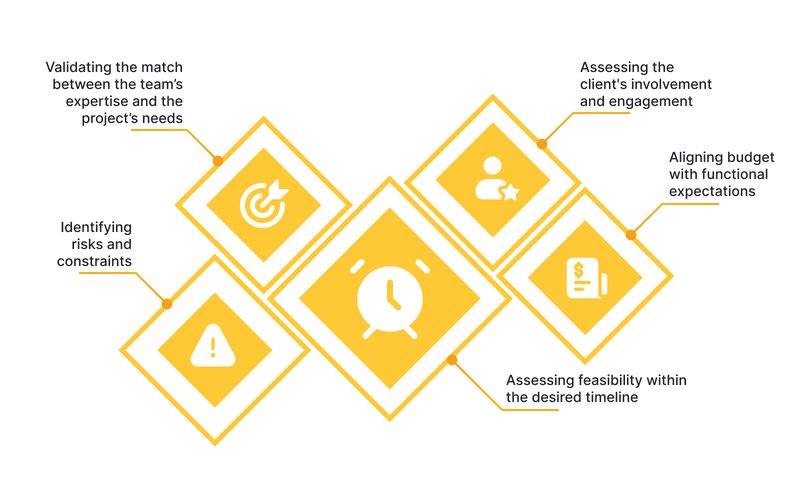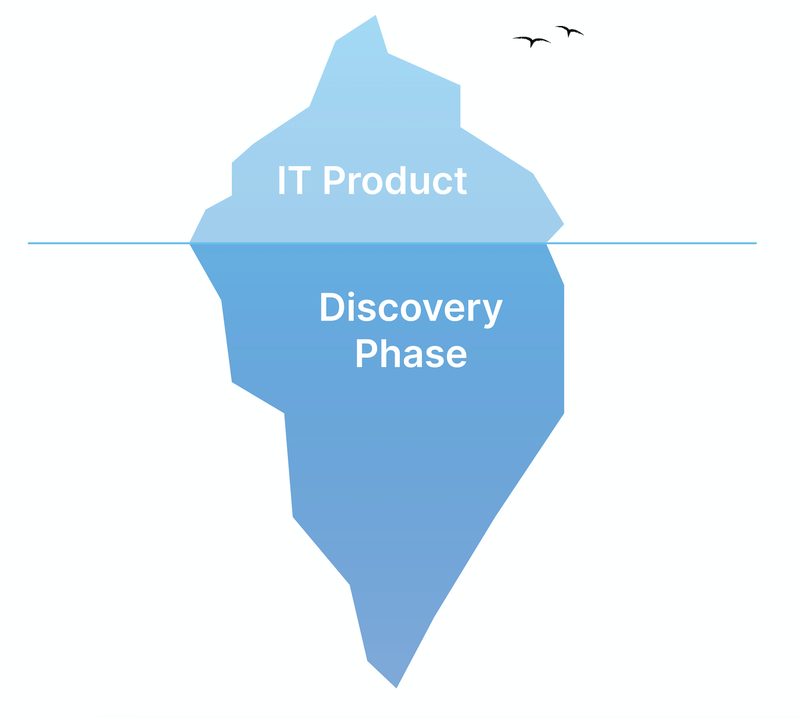Understanding the Discovery Phase in software development: Part 1

This phase isn’t just about gathering requirements; it’s about creating a shared understanding that guides the entire project, helping to identify risks, validate ideas, and refine the project’s scope and budget. By the end of this phase, both the client and the development team are aligned, making it easier to move forward with the project with confidence.
In this post, you’ll gain insight into why the Discovery Phase is such a crucial step in any project’s success. We’ll explore the main objectives of this phase, including identifying potential risks and validating expertise, as well as aligning budgets and assessing project feasibility.
What is the Discovery Phase?
When we engage with a new client, we typically don’t yet know exactly what they need, and they, in turn, don’t fully understand our processes and approaches. In such cases, rather than rushing into development, we propose beginning with a Discovery Phase — a stage that helps both sides build a shared understanding of objectives, goals, and collaboration practices.
The software project Discovery Phase is a stage of analysis and planning focused on shaping a unified vision of the future product. Its main task is to answer key questions: what exactly needs to be built, for whom, why, and how. This phase goes beyond simple requirement gathering — it acts as a bridge between an idea and its implementation, laying the foundation for a thoughtful and effective development process.
At this stage, the project team (more on that later) deeply immerses itself in the client’s business context, studies the goals and problems the product must address, clarifies user needs, and conducts an initial technical and organizational feasibility assessment.
Key objectives of the Discovery Phase

- Identifying risks and constraints. This involves surfacing potential issues that could impact implementation — technical, organizational, legal, or business-related. Early software development risk assessment allows us to develop mitigation strategies before the main development begins.
- Validating the match between our team’s expertise and the project’s needs. Not every project is the right fit. Discovery helps determine whether the initiative aligns with our competencies, technology stack, and available resources. This reduces the chances of unsuccessful engagements and helps set realistic expectations for quality and delivery.
- Assessing the client's involvement and engagement. Not every client is the right fit, either. Occasionally, Discovery reveals that continuing the partnership may not be advisable. The main reason is low stakeholder engagement. Discovery is a "two-person tango": no matter how qualified our team is, if we don’t receive sufficient information, context, or interest from the client, the project's success is jeopardized. It’s better to recognize this early rather than further down the line.
- Aligning the budget with functional expectations. Clients often come with ambitious ideas but little understanding of cost. The benefit of the Discovery Phase is in the fact it helps reconcile the available budget with the desired scope and, if needed, identify compromises — for example, by isolating a viable MVP or revisiting feature priorities.
- Assessing feasibility within the desired timeline. Clients may have deadlines in mind that aren’t grounded in development reality. During Discovery, we develop a more accurate and justified timeline based on the actual complexity and effort involved.
As a result, the Discovery Phase produces more than just a set of requirements — it delivers a shared understanding of context, clarity in decision-making, and alignment among all participants. Without this foundation, further development efforts risk being inefficient or even futile.
When and how to conduct a Discovery Phase?
At first glance, the Discovery Phase might seem like an optional step — something that can be skipped to save time or money. However, as highlighted by the Project Management Institute, initiating IT projects without a thorough planning phase can lead to scope misalignment and increased risks. In practice, this phase often proves to be the very element that determines a project's success.
In some situations, Discovery isn’t just helpful — it becomes critical. Below are typical signs that skipping the Discovery Phase consulting would dramatically increase the risks of failure:
- Numerous external integrations. Each integration is a potential source of risk: technical, organizational, or legal. Working with third-party systems demands a clear understanding of protocols, data formats, synchronization schedules, and potential limitations. All of this must be studied and clarified during Discovery.
- The client has a weak understanding of their business processes. If the client doesn’t fully grasp how their future solution should function, Discovery becomes essential for shaping the product’s concept. The team must investigate how processes work, define where scenarios begin and end (both primary and alternative), and identify all necessary user roles.
- Vague understanding of the target audience. Sometimes clients have only a general idea of who their end users are, how they will use the product, and what their goals and pain points are. This introduces a high risk of building functionality that lacks demand. In such cases, Discovery helps the team analyze user personas and usage scenarios.
- Complex or convoluted business logic. The more exceptions, alternate flows, and dependencies on external conditions a process contains, the more crucial it is to predefine, optimize, and document every possible scenario in advance.
- Unstructured and unprioritized scope. When a client presents a long, unclear list of "wants" without any structure or priorities, it’s essential to break down the project into logical stages, establish priorities, and identify what can be postponed or excluded.
It’s not uncommon for clients to truly understand their needs only after a high-quality Discovery process. This shared clarity allows both sides to choose the best path forward — one that is realistic, structured, and achievable.
Discovery Phase duration
The duration of the Discovery Phase for a startup or MVP depends not only on the planned scope of functionality but also on a variety of other factors. There is no universal "standard" timeline — the length can vary significantly depending on the specifics of the project, the maturity of the client’s idea, and the quality of input data. Our approach is to always consider the context and adapt flexibly.
Key factors affecting duration:
1) Scope and complexity of functionality
This is the most critical factor. Naturally, the more features and logic that need to be analyzed and described, the more time is required. Examples:
- Simple project — landing page, single-page application, or MVP with limited scenarios: 1–2 weeks.
- Medium complexity — e-commerce solution, CRM/ERP for a small business with basic integrations: 2–6 weeks.
- Complex project — fintech product, CRM/ERP for a large enterprise: 2 months or more.
In practice, most clients are eager to start development quickly. Prolonged analysis increases the risk of outdated requirements and momentum loss. Therefore, if preliminary estimates show that Discovery may take longer than 3–4 months, we suggest focusing on an MVP-first approach:
- Define the critical functionality required for the initial release.
- Conduct Discovery only for the MVP (typically 4–8 weeks).
- Move into the development of the MVP.
- Continue Discovery for the next phase in parallel.
This allows faster time-to-market, early feedback from users, and structured system architecture design.
2) Availability and quality of initial materials
One of the most important factors that can either accelerate or significantly delay the Discovery process is the quality and quantity of input materials provided by the client. These may include:
- Text descriptions of the product concept
- User stories and usage scenarios
- Business process diagrams
- Prototypes or wireframes
- References to similar products or competitors
- Documentation on planned integrations
When such materials are available and of good quality, the team can quickly proceed to analysis, requirements structuring, and solution design. Otherwise, a large portion of time is spent on:
- Interviews and information-gathering sessions
- Building the contextual foundation
- Interpreting the client’s expectations "between the lines"
3) Complexity of business logic and processes
Projects involving many exceptions, non-standard flows, and dependencies take more time to formalize and visualize. This often involves modeling using BPMN/UML, defining user roles and permissions, and describing alternate paths.
Logically complex processes require iterative elaboration: starting with a baseline flow and gradually expanding with exceptions and refinements. This usually cannot be done in a single session and requires:
- Alternate scenarios
- Exceptions and edge cases
- Role-based access rules
- Dependencies on external conditions
4) Stakeholder availability
Even a well-organized vendor team cannot maintain momentum if the client’s stakeholders respond slowly, skip meetings, or frequently change direction. These issues slow down progress and increase the overall Discovery timeline.
Who participates in the Discovery Phase?
The Discovery Phase is a collaborative effort that involves specialists from various disciplines. Their combined expertise enables a comprehensive exploration of the project, covering business needs, user experience, technical system architecture planning, and process management. The success of this phase directly depends on the alignment and quality of their collaboration.
Below are the key roles and responsibilities of the specialists typically involved in the Discovery Phase on our side.
Project Manager (PM)
- Coordinates all team members.
- Organizes meetings, manages scheduling, and monitors deadlines.
- Oversees resource allocation and ensures smooth communication between the team and the client.
- Facilitates discussions and removes blockers.
The PM is like a conductor, ensuring every part of the Discovery process runs on time and in harmony.
Business Analyst (BA)
- Identifies, analyzes, and documents requirements.
- Builds the logical model of the future system and defines usage scenarios.
- Acts as a bridge between the business side and the technical team.
- Analyzes risks, constraints, and helps with prioritization.
On larger projects, a group of business analysts may work together to divide responsibilities and increase efficiency.
UX/UI Designer
- Responsible for the visual and logical aspects of the future product.
- Collaborates with the Business Analyst to develop user flows, navigation structures, and wireframes.
- Makes UX decisions and designs interfaces.
Designers play a critical role, especially when clients need visual representations to better grasp the end product.
Technical Lead / System Architect
- Assesses the technical feasibility of proposed solutions.
- Defines system architecture and selects the technology stack.
- Analyzes risks and provides mitigation strategies.
- Participates in designing integrations and defining non-functional requirements (performance, security, scalability, etc.).
The technical team structure may vary: some projects involve a single architect, while others require multiple tech leads specializing in front-end, back-end, or mobile development.
The exact composition of the Discovery team depends on the scale and specifics of the project. In smaller projects, several roles might be combined — for example, a Business Analyst may also produce wireframes. In larger or more complex projects, each role is filled by a dedicated specialist or even a small team.
A successful Discovery Phase requires an engaged, multidisciplinary team. Each member brings their area of expertise, contributing to a shared understanding of the product and laying a strong foundation for future development.
What are the levels of requirement detail?
At our company, we use a multi-level approach to organizing the Discovery Phase. This model allows us to adapt based on the maturity of the client's idea, the quality of the initial input, and their business goals. It provides flexibility, predictability, and an optimal balance between depth of analysis and preparation speed.
This approach is especially valuable because each project starts with different circumstances. Sometimes the client urgently needs a feasibility assessment to decide whether to move forward. In other cases, there is no rush — what’s needed is a well-considered system architecture, clarification of technical constraints, and alignment of complex processes.
Our tiered model ensures a deliberate and effective approach to Discovery, avoiding unnecessary overwork while capturing all critical aspects.

Level 0: Pre-discovery
This is a preparatory stage that precedes a full Discovery Phase. It’s used in situations where:
- The effort required for Discovery needs to be assessed.
- A decision must be made on whether the project is viable in its current form.
- There’s high uncertainty or considerable technical risk.
Pre-discovery does not involve full-scale requirement gathering — it functions as a navigation tool to help determine the feasibility and scale of deeper analysis.
Level A: Limited Discovery
This level applies to small projects where the client has a basic understanding of the idea but lacks detailed requirements. Information is insufficient for creating a full picture.
Objectives at this level:
- Develop an initial concept and system structure.
- Identify key entities and business scenarios.
- Validate early hypotheses.
This format is ideal for preparing for agile development — instead of defining everything upfront, we create a foundation for initial iterations and future refinement.
Level B: Extended Discovery
Used when the client has a clearer idea of the product, and the goal is to:
- Conduct a detailed requirement analysis.
- Align business logic and prioritize tasks.
- Research the market, target users, and competitors;
- Estimate timelines, resources, and budget.
This is a full analytical phase, resulting in a structured product view, specifications, prototypes, and a realistic development forecast. It allows for immediate transition into implementation.
Level C: Comprehensive product design
At this level, we develop a deeply detailed model of the future system, including technical realization. It is appropriate when the product:
- It is complex and component-heavy;
- Requires detailed planning of architecture, integrations, and technology decisions;
- Has strict non-functional requirements (e.g., performance, security).
This phase includes technical specialists, architects, and designers. We work through non-functional requirements, define the technology stack, and document system interfaces. The output is a comprehensive technical specification ready for immediate development.
The multi-level Discovery model enables us to tailor the scope of deliverables to each project. It avoids unnecessary deep dives where they’re not needed, while ensuring no critical detail is overlooked.
Conclusion
The Discovery Phase is a pivotal part of any successful project, as it provides clarity, alignment, and a roadmap for the development process. By identifying potential risks, validating ideas, and aligning the team’s expertise with the client’s goals, the Discovery Phase ensures that the project progresses with a strong, unified vision. Whether it’s assessing technical feasibility, clarifying business requirements, or identifying user needs, this stage sets the tone for everything that follows.
Stay tuned for Part 2, where we’ll dive deeper into what the client gains from the Discovery Phase, what we gain as a provider, and the next steps after the Discovery process. If you're ready to set your project up for success, make sure to kick off with a thorough Discovery Phase — it’s the first step in building a product that works, on time and within budget.